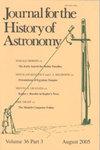晚期巴比伦天文学和占星术
IF 0.3
3区 哲学
Q3 HISTORY & PHILOSOPHY OF SCIENCE
引用次数: 0
摘要
这种复制笔记本的方法的一个优点是,当Amici记录他的测量值、绘制双星方向、计算平均值,有时还会在边缘涂鸦时,读者可以从观察者的肩膀上窥视(例如,见第137页)。它还提供了明显的信息,如果阿米奇出版了他的目录,这些信息可能已经消失了。例如,尽管他在1825年2月的一封信中告诉赫歇尔,观测到这颗行星“将把你家族的光荣名字传给后人”(没有意识到赫歇尔从未将天王星称为“赫歇尔”),但阿米奇当晚的笔记本显示这是一个外交谎言。事实上,他记录了他测量的“Urano的直径”(它是4.085“;见第37119页)。另一方面,由于缺乏索引,对特定数据感兴趣的读者不得不按时间顺序在笔记本上搜索物体何时可见。例如,赫歇尔在摩德纳与阿米奇会合并测量木星直径以测试阿米奇新千分尺的那晚的观测结果只出现在第二本笔记本最后一页的“回忆”中(第139页),很容易被遗漏。同样,当γVirginis的组成部分向最接近的方向摆动时,赫歇尔协调了对这颗突出双星的尽可能多的观测。阿米奇在1815年4月30日测量了这颗恒星,当时它处于一个舒适的分离状态(第111页),但他又观测到了吗?这种复制品的在线版本虽然浏览起来不那么愉快,但可能会通过搜索功能回答这样的问题。该卷还包括Amici天文图书馆的清单,并以引人注目的全彩图版结尾,包括Amici仪器的图像,并配有意大利语和英语的描述性说明。Amici的双星目录构成了他的作品和信件的重要组成部分,因此,这本精心制作的书成为Edizione不可或缺的一部分。本文章由计算机程序翻译,如有差异,请以英文原文为准。
Late Babylonian astronomy and astrology
An advantage to this approach of reproducing the notebooks is that it lets a reader peer over the observer’s shoulder as Amici records his measurements, sketches double star orientations, calculates average values, and sometimes doodles on the margins (see for instance p. 137). It also makes apparent information that may have disappeared had Amici ever published his catalog. For example, though he tells Herschel in a letter of February 1825 of observing the planet that “will hand down to posterity the glorious name of your family” (not realizing Herschel never referred to Uranus as “Herschel”), Amici’s notebook from that night reveals this to be a diplomatic lie. He records, in fact, that he measured the “diametro di Urano.” (It was 4.085”; see pp. 37, 119). On the other hand, the lack of an index forces readers interested in specific data to search the notebooks chronologically for when an object would have been visible. For example, observations from the night Herschel joined Amici at Modena and measured the diameter of Jupiter to test Amici’s new micrometer only appear in a “Memoria” on the final page of the second notebook (p. 139), easily missed. Likewise, as the components of γ Virginis swung toward their closest approach, Herschel coordinated as many observations of the prominent double star as possible. Amici measured the star on 30 April 1815, when it was at a comfortable separation (p. 111), but did he ever observe it again? An online version of this reproduction, though not as enjoyable to leaf through, might answer such a question with search functionality. The volume also includes an inventory of Amici’s astronomical library and concludes with attractive full-color plates, including images of Amici’s instruments with descriptive captions in Italian and English. Amici’s double star catalog formed a significant part of his works and correspondence, and this lovingly-produced volume thus forms an integral part of the Edizione.
求助全文
通过发布文献求助,成功后即可免费获取论文全文。
去求助
来源期刊

Journal for the History of Astronomy
地学天文-科学史与科学哲学
CiteScore
0.50
自引率
25.00%
发文量
44
审稿时长
>12 weeks
期刊介绍:
Science History Publications Ltd is an academic publishing company established in 1971 and based in Cambridge, England. We specialize in journals in history of science and in particular history of astronomy.
 求助内容:
求助内容: 应助结果提醒方式:
应助结果提醒方式:


